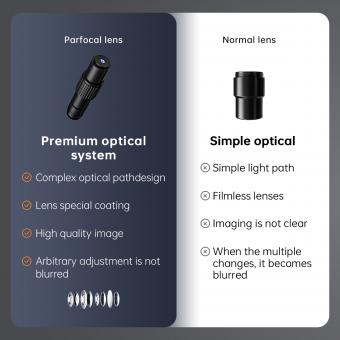What Is An Objective On A Microscope ?
An objective on a microscope is a lens or a set of lenses that is responsible for magnifying the specimen being observed. It is located close to the specimen and is one of the key components of a microscope. The objective lens gathers light from the specimen and forms a magnified image that can be further observed or captured by the eyepiece or camera attached to the microscope. Objectives come in different magnification powers, typically ranging from 4x to 100x or higher, allowing users to view specimens at various levels of detail. The quality and design of the objective lens greatly influence the clarity, resolution, and overall performance of the microscope.
1、 Magnification: Increasing the size of the specimen for detailed observation.
An objective on a microscope refers to the lens or lenses that are closest to the specimen being observed. It is one of the key components of a microscope and plays a crucial role in magnifying the specimen for detailed observation. The objective lens is responsible for gathering light from the specimen and focusing it to create a magnified image that can be viewed through the eyepiece.
Magnification is the primary function of the objective lens. By increasing the size of the specimen, it allows for a more detailed observation of its structure and features. The objective lens typically has multiple magnification options, ranging from low to high power, allowing the user to choose the appropriate level of magnification based on the specimen and the desired level of detail.
In recent years, advancements in microscope technology have led to the development of objectives with higher magnification capabilities. High-resolution objectives with increased numerical aperture (NA) have become more common, enabling researchers to observe specimens at a finer level of detail. These objectives often incorporate specialized coatings and designs to enhance image quality and reduce aberrations.
Additionally, some modern microscopes now offer objectives with adjustable magnification, allowing for seamless transitions between different magnification levels without the need to switch objectives. This feature enhances convenience and efficiency during microscopy experiments.
In conclusion, the objective on a microscope is responsible for magnifying the specimen to enable detailed observation. With advancements in technology, objectives with higher magnification capabilities and improved image quality have become more prevalent, enhancing the capabilities of modern microscopes.

2、 Resolution: Ability to distinguish fine details and separate closely spaced objects.
An objective on a microscope refers to the lens or lenses that are closest to the specimen being observed. It is a crucial component of the microscope that plays a significant role in determining the quality and clarity of the image produced. The objective lens is responsible for gathering light from the specimen and magnifying it to create a detailed image that can be viewed by the user.
One of the most important characteristics of an objective lens is its resolution. Resolution refers to the ability of the lens to distinguish fine details and separate closely spaced objects. In other words, it determines how clear and sharp the image will be. The higher the resolution of the objective lens, the more detail can be observed in the specimen.
Resolution is influenced by several factors, including the numerical aperture (NA) of the lens and the wavelength of light used. The numerical aperture is a measure of the lens's ability to gather light and is determined by the design and quality of the lens. A higher numerical aperture generally results in better resolution.
Advancements in technology have led to the development of objectives with improved resolution. For example, the introduction of high numerical aperture objectives and the use of specialized techniques such as confocal microscopy and super-resolution microscopy have significantly enhanced the resolution capabilities of microscopes. These advancements have allowed scientists and researchers to observe and study structures and processes at the nanoscale level, opening up new possibilities in various fields such as biology, medicine, and materials science.
In conclusion, an objective on a microscope is a lens that is responsible for gathering light from the specimen and magnifying it to create a detailed image. The resolution of the objective lens determines the ability to distinguish fine details and separate closely spaced objects. Recent advancements in technology have led to the development of objectives with improved resolution, enabling scientists to explore the microscopic world with greater clarity and precision.

3、 Illumination: Providing adequate light to enhance visibility of the specimen.
An objective on a microscope refers to the lens or system of lenses that is closest to the specimen being observed. It plays a crucial role in magnifying the image of the specimen and providing clear visibility. The objective lens is typically located on a rotating nosepiece and can be interchanged with other objectives of varying magnification powers.
The primary objective of an objective lens is to gather and focus light onto the specimen, allowing for a detailed and enlarged view. Illumination is a key aspect of this process, as it provides adequate light to enhance visibility. Proper illumination ensures that the specimen is well-lit and that its features are clearly distinguishable. This is particularly important when observing transparent or translucent specimens, as they may require additional light to enhance contrast.
In recent years, advancements in microscope technology have led to improvements in illumination techniques. For example, LED (light-emitting diode) illumination has become increasingly popular due to its energy efficiency, long lifespan, and ability to produce bright and uniform light. LED illumination also allows for better control of light intensity and color temperature, enabling researchers to optimize the lighting conditions for different types of specimens.
Additionally, some microscopes now incorporate advanced illumination methods such as darkfield and phase contrast microscopy. Darkfield microscopy involves illuminating the specimen with oblique or scattered light, resulting in a bright specimen against a dark background. This technique is particularly useful for observing unstained or transparent specimens. Phase contrast microscopy, on the other hand, enhances the contrast of transparent specimens by converting differences in refractive index into variations in brightness.
In conclusion, while the primary objective of an objective lens on a microscope remains the same - to provide adequate light for enhanced visibility of the specimen - advancements in illumination techniques have allowed for improved imaging and observation capabilities. These advancements have contributed to the development of more efficient and versatile microscopes, enabling researchers to explore the microscopic world with greater clarity and precision.

4、 Focusing: Adjusting the focus to achieve a clear and sharp image.
An objective on a microscope refers to the lens or set of lenses that are closest to the specimen being observed. It is one of the essential components of a microscope and plays a crucial role in magnifying and focusing the image. The objective lens is responsible for gathering light from the specimen and forming a magnified image that can be viewed through the eyepiece.
The primary objective of an objective lens is to achieve a clear and sharp image of the specimen under observation. This is done by adjusting the focus of the microscope. Focusing involves moving the objective lens closer or farther away from the specimen to bring it into clear view. By adjusting the focus, the microscope user can ensure that the image is in focus and free from any blurriness or distortion.
In recent years, there have been advancements in microscope technology that have improved the focusing capabilities of objectives. For example, some microscopes now come with motorized focusing systems that allow for precise and automated adjustments. This can be particularly useful when observing delicate or time-sensitive specimens, as it reduces the risk of disturbing the sample during focusing.
Additionally, some modern microscopes also incorporate advanced imaging techniques such as confocal microscopy or phase contrast microscopy, which further enhance the clarity and sharpness of the image. These techniques work in conjunction with the objective lens to provide detailed and high-resolution images of the specimen.
In conclusion, the objective on a microscope is responsible for focusing the image and achieving clarity and sharpness. With advancements in technology, the focusing capabilities of objectives have improved, allowing for more precise and automated adjustments. These advancements, along with the incorporation of advanced imaging techniques, have greatly enhanced the quality of microscopic observations.







































